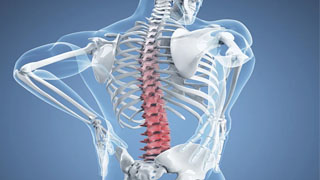
Scoliosis may cause incorrect body posture, discomfort, and other functional problems, so it is necessary to find ways to alleviate symptoms and improve quality of life. "Exercise" is considered to be helpful in the treatment of scoliosis, but the situation of each scoliosis patient is different. Therefore, it is best to consult a doctor or physical therapist for advice before choosing a suitable exercise plan.
How to detect scoliosis
1. Adam Forward Bend Test
Please bend the subject forward to 90 degrees, with both hands hanging flat shoulders. The examiner should stand behind the subject and observe the appearance of the back from the side. The examiner should stand behind the subject and observe the appearance of the back from the side. If the back spine is bent laterally or the height of the left and right backs is different, it is suspected that there is scoliosis.
2. X-ray diagnosis
Cobb angle, The angle obtained by measuring the intersection of the vertical lines of the most inclined vertebral body above and below the spine on an X-ray is called the scoliosis angle.
Cracking the myth of scoliosis
Swimming may not necessarily be effective
Is backpacking, poor posture, and scoliosis related?
Backpacking, running, and poor posture do not cause scoliosis and are not directly related. Non medical professional massage and bone shaping are not helpful in correcting scoliosis!
Can scoliosis be corrected by swimming?
Regarding swimming correction, previous studies have made different findings:
(1) Swimming is associated with an increased risk of trunk asymmetry, and the risk is higher for girls.
(2) In the study, there was a significant difference in angle of trunk rotation (ATR) among female students.
(3) For women, the risk of lower back pain also increases.
In summary, swimming does not achieve the effect of correcting primary scoliosis in adolescents, but instead increases the risk of trunk asymmetry and rotation. Girls have a higher rate of deterioration, which also increases the risk of lower back pain in women.
How to treat scoliosis
1. Physical therapy and corrective exercise
There are currently seven major spinal scoliosis correction exercises, all of which have shown significant correction effects in research. Based on each person's scoliosis type, appropriate and suitable treatment courses should be given. 2. Back frame
Based on different types of lateral bending, design a fitted corrective brace that utilizes three-point mechanics, conformal correction, and rotational breathing to achieve corrective effects.
Will scoliosis be okay?
According to a study in 2018, the spinal scoliosis correction exercise system Schr ö th showed significant improvements in scoliosis angle, body symmetry, body rotation angle, muscle strength, chest expansion, balance, and quality of life for patients with 10-30 degrees and moderate scoliosis angle for at least 1 hour per day for at least 6 months!
Exercise can help with cornering:
1. Practice inducing low tension muscle groups in different positions
2. Use breathing training to learn about concave side extension
3. Each plane can maintain spinal neutrality
4. Daily practice
The same type of scoliosis, in fact, everyone's muscle tension is different, and different movements and breaths must be used to induce it.
Can scoliosis be retrained or exercised?
Previous studies measured surface electromyography (S-EMG) to explore the degree of muscle activation in these cases as a basis for our exercise design. The study found that the paraspinal muscles on the concave side had higher muscle tension and were associated with the severity of scoliosis. There are also studies that have come up with different conclusions, finding the opposite result: the muscle tension of the paravertebral muscles on the convex side of the back is actually higher than that on the concave side.
Therefore, for cases of scoliosis, asymmetric exercise design is crucial, so it is best to have a professional physical therapist and coach discuss the exercise plan for scoliosis to avoid injury and worsen the condition.
The treatment of scoliosis must be evaluated and treated by professionals
1. For primary scoliosis, it is recommended to choose Physiotherapy Scoliosis Specific Exercises (PSSE) that have been proven in literature.
According to the guidelines of the International Society of Orthopaedic and Rehabilitation Therapy for Scoliosis (SOSORT), the benefits of exercise are emphasized, but it cannot be used as a treatment policy for correcting scoliosis.
3. Currently, for primary scoliosis, it is necessary to seek professional medical personnel, physicians, and physical therapists to intervene at appropriate times, assess the risk of deterioration, intervene in the back frame, and design personalized exercises!


